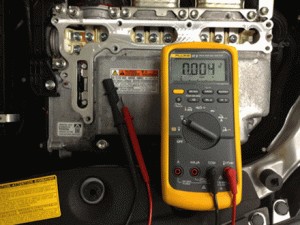As the automotive industry advances, the intricacies of vehicle electrical systems become increasingly complex. For automotive technicians, a solid grasp of the fundamentals of Car Electrical System Diagnosis is more critical than ever. While modern vehicles boast sophisticated electronics and networks, the core principles of electrical troubleshooting remain the bedrock of effective and efficient repairs. Leading experts in automotive diagnostics consistently emphasize several key areas that form the foundation of successful electrical system analysis. These include the indispensable nature of accurate wiring schematics, the holistic approach to viewing the electrical system, recognizing how issues in one area can manifest elsewhere, the proven effectiveness of voltage drop testing, and the critical role of good ground connections. Let’s revisit these essential basics to sharpen our diagnostic skills and ensure we’re equipped to tackle any electrical challenge.
The Battery: The Heart of the System
When it comes to car electrical system diagnosis, virtually every seasoned technician will tell you to start with the battery. Countless experts underscore the absolute necessity of ensuring the battery is in optimal condition and fully charged before attempting any electrical diagnosis. Diagnosing electrical problems accurately on a vehicle with a weak or faulty battery is a near impossible task. But what factors contribute to battery degradation and failure? Larry Carley’s insightful article in Counterman delves into this very question.
Battery sales typically peak twice annually, coinciding with the extremes of summer heat and winter cold. Heat accelerates battery degradation by increasing water evaporation from the cells, even in sealed designs. Conversely, cold temperatures diminish a battery’s cranking power, forcing it to work harder to start a cold engine… Read more
Wiring Schematics and Voltage Drop Testing: A Powerful Diagnostic Duo
Bob Chabot’s article in Motor Magazine masterfully integrates several crucial diagnostic concepts, presenting a clear and comprehensive guide to car electrical system diagnosis. He emphasizes the profound value of a systematic diagnostic approach, highlighting its benefits for both the automotive shop’s profitability and the technician’s earning potential.
Alt text: Technician using a multimeter to perform voltage drop testing on a car electrical system, emphasizing systematic diagnostics for shop profits and technician earnings.
“The foundational principles and their practical application are becoming increasingly central to the industry. The rising complexity of software, electronics, and networking in contemporary and emerging vehicles elevates diagnostic proficiency to a key differentiator for shop profitability and technician income.” Read More
This quote underscores the growing importance of mastering fundamental diagnostic techniques in the face of increasingly complex automotive electrical systems. Combining wiring schematics with voltage drop testing allows technicians to systematically trace circuits, identify faults, and pinpoint the root cause of issues like parasitic draws with greater precision and efficiency.
Bridging Theory and Real-World Electrical Challenges
Dave Macholz, writing in Motor Age, effectively bridges the gap between theoretical electrical principles and their practical application in real-world automotive electrical dilemmas. He aptly points out:
Alt text: Electrical circuit diagram illustrating basic electrical principles applicable to car electrical system diagnosis in real-world scenarios.
“While electrical principles are readily understood in a classroom setting, their application to real-world scenarios can sometimes be challenging to visualize. However, basic electrical principles are inherently used in numerous diagnostic applications, whether consciously recognized or not.” He proceeds to illustrate several instances where applying electrical theory directly aids technicians in effectively diagnosing and resolving the underlying causes of electrical problems in vehicles. Read More
Understanding Ohm’s Law, circuit laws, and basic electrical theory provides the framework for interpreting diagnostic data and systematically troubleshooting even the most complex electrical faults.
Voltage Drop Testing: Mastering the Fundamentals
Voltage drop testing is a frequently discussed topic in automotive trade publications, and for good reason. Its effectiveness in car electrical system diagnosis is widely recognized. In an article from SearchAutoParts.com, Bernie Thompson of Automotive Test Solutions expertly reviews the theory underpinning voltage drop testing, explaining the intricate relationships between voltage, current, and resistance – essentially, the practical application of Ohm’s Law in diagnostics.
Thompson concludes, “With a foundational understanding of these principles and consistent practice, navigating these complex systems becomes manageable. When diagnosing modern vehicles, always prioritize following the data. The data gathered during your diagnostic process will invariably guide you towards the source of the problem.” Read More
Mastering voltage drop testing empowers technicians to efficiently identify excessive resistance in circuits, pinpointing issues like corroded connections, faulty wiring, and other common electrical problems that impede system performance.
The Importance of Ground Connections
Faulty ground connections are a surprisingly frequent culprit behind a wide range of electrical problems in vehicles. This is a recurring theme in online automotive technician forums like iATN, where real-world case studies consistently highlight the impact of poor grounds. Even seemingly unrelated issues can often be traced back to a compromised ground connection.
Alt text: Corroded ground connection on a BMW chassis, illustrating a common cause of electrical problems and the importance of checking ground points in car electrical system diagnosis.
Recent examples vividly illustrate the impact of poor ground connections on system performance. The first case details a loss of power across multiple components due to corrosion in chassis grounds. The second describes a no-start condition stemming from a deficient engine ground.
Regularly inspecting and ensuring the integrity of ground connections is a crucial step in any comprehensive car electrical system diagnosis process. Overlooking this fundamental aspect can lead to misdiagnosis and prolonged troubleshooting efforts.
Conclusion: Back to Basics for Advanced Diagnostics
This review serves as a valuable reminder of the enduring importance of fundamental principles in car electrical system diagnosis. As vehicle technology advances, a strong foundation in these basics will be the key to effectively and efficiently diagnosing even the most complex electrical issues. We encourage you to explore the “Articles” section of our website for further resources and in-depth explorations of these and related topics. The collective wisdom of electrical system experts like Gary Goms, Pete Meier, Andrew Markel, and Albin Moore, among others, provides invaluable guidance for navigating the ever-evolving landscape of automotive electrical systems. By consistently reinforcing our understanding of these core principles, we empower ourselves to excel in the field of automotive diagnostics, ensuring both accuracy and efficiency in our service.

